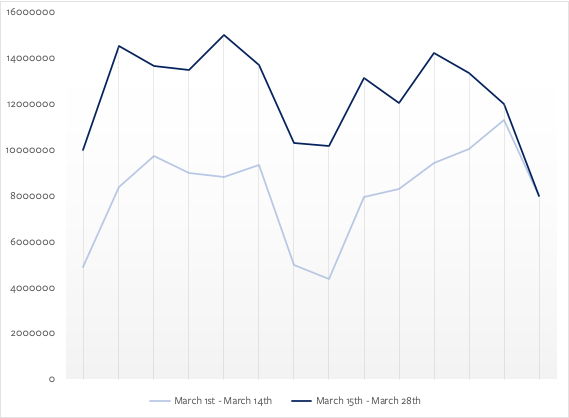SOCIAL
New Research from Facebook Shows Engagement with Local News Providers Booming Amid COVID-19

Given the rapid evolution, and massive impact of COVID-19, on everybody, it’ll come as little surprise to discover that news organizations are seeing significant increases in online engagement at present.
But the specifics of that engagement could reveal some valuable insights for your own content approach. This week, Facebook’s CrowdTangle analytics platform has published a new overview of Facebook Page engagement stats from over 2,700 US local news publishers’ during March and the first half of April 2020.
And again, while the broader trends are as you might expect, the detail is interesting to note.
First off, CrowdTangle says that local news pages saw a big spike in interest as COVID-19 cases began to rise in the US in mid-march.
“In the second half of March, US local news organizations’ Facebook Pages grew 150% in new Page likes, and interactions per post such as shares, reactions or comments increased 33%, compared to the first half of March.”

Again, that’s probably as you would expect – but CrowdTangle’s data goes further, looking at which post types, specifically, have garnered more interest.
“Between the first and last half of March, interactions per post increased on live videos by 60%, on photos by 60%, on status posts by 50% and on links by 30%.”

Facebook Live remains the leading option for engagement – and while the data here is news content specific, and not overall Facebook Page trends, it is interesting to see the ongoing audience interest in Facebook Live, which could help provide some more guidance for your own strategy.
That’s particularly relevant given that Facebook Live videos are the third most utilized option by local news Pages.

Those trends would likely hold across most Facebook Page types – while Facebook Live generates significantly more engagement on average, link and image posts are used far more frequently.
Of course, that makes sense. Broadcasting live comes with a higher degree of risk, and difficulty – it can be tough to create entertaining, interesting live broadcasts, especially when it’s just you talking to a camera lens. That’s partly why so many Pages were happy to see Facebook bring back its ‘Live with’ guest functionality for streams, reducing the pressure on the main host, while Facebook has also recently rolled out a range of updates to its Live Producer platform to make it easier to create more professional looking live-streams.
Clearly, based on the data here, it’s worth consideration – and while this is, again, data on local news publishers specifically, it points to where people are engaging, which could be relevant for your approach.
But what does this mean for local publishers?
Sure, they’re seeing a lot more engagement on their Facebook Pages, and other reports have shown that news publishers overall are seeing significant increases in traffic. Yet, despite this, many local news organizations are being forced to shut down amid the COVID-19 lockdowns, because most of them rely on advertising from local businesses that are currently not operating due to the restrictions.
So despite CrowdTangle reporting that people are sharing Facebook posts from local US publishers’ 40% more during the pandemic, that isn’t generally being reflected in publisher bottom lines.
For its part, Facebook has committed more than $100 million to supporting local newsrooms, which is in addition to the $300 million it pledged in January to help fund local news programs. But Facebook could, potentially, do more, with respect to revenue sharing and contributions to the news providers that help it generate a lot of its on-platform engagement.
Recently, the Australian Government announced that it’s looking to implement a new, mandatory code of conduct which would require both Facebook and Google to share any revenue they generate as a result of news content with the relevant publishers of such material. Various nations have tried this in the past, and largely failed, but Australia believes it will be able to implement a system that facilitates revenue sharing with publishers, helping to supplement money they’ve have lost in ad spend to the digital giants.
Of course, neither Facebook nor Google agrees with this logic. Google has countered most of these arguments in the past by noting that it actually drives more traffic to publishers by including their content in its listings , and if selected publishers are unhappy with this arrangement, Google has offered to remove them from its index – leading to a worse result for both. But maybe, through alternate means, there is a way that Governments could facilitate more revenue sharing between the parties to better support the news industry.
In a great overview of the challenges of such approaches published by OneZero this week, one option suggested would see the tech giants face new taxes, with the resulting revenues funneled into support programs for the publishing sector. That seems like a more logical, workable approach than forcing Facebook and Google to pay for using news content, which, history shows, they absolutely will not do.
And in many respects, they’re right to reject such calls – but clearly, there’s a problem when traffic to local news publishers is so high, and revenues from such are so low. Part of that is unique to COVID-19, of course, but the data here underlines the value of local publishers, and why we should be looking to save them with improved measures, if and where possible.
You can read CrowdTangle’s full COVID-19 trend report here.
